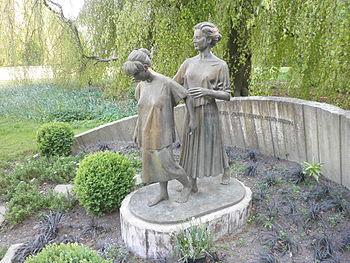
English: War memorial in remembrance of 10 members of the Dutch resistance executed by the Sicherheitsdienst (SD) during the last days of the German occupation in the Second World War. Nederlands: Oorlogsmonument ter herinnering aan 10 leden van het verzet die door de Sicherheitsdienst (SD) zijn vermoord in de laatste dagen van de Duitse bezetting tijdens de Tweede Wereldoorlog. (Photo credit: Wikipedia)
Different generations obviously have different perceptions of the Second World War and the remembrance and liberation ceremonies. The events organized to commemorate the war center on themes which are relevant today to people of all ages and backgrounds. Over the past few years, Liberation Day has become a day on which the country unites to reflect on freedom and democracy.
Just as a number of European nations celebrate Victory in Europe Day on 8 May, the Netherlands pulls out all the stops for Liberation Day (Bevrijdingsdag) a few days earlier on 5 May. The day commemorates the German army's surrender in the Netherlands on 5 May 1945 and the liberation of the country, just prior to the end of World War II in Europe.
Amsterdam joins the rest of the Netherlands on 4 May when its citizens pause to pay their respects to the victims and fallen soldiers of World War II, as well as more recent military conflicts and peacekeeping operations. Then it's time for a national party on 5 May, as the crowds take to the streets to celebrate their freedom on Liberation Day. The entire nation participates in a two-minute period of silence evening at 20:00 in remembrance of all Dutch citizens and members of the armed forces who lost their lives in World War II and in remembrance of all Dutch nationals who have lost their lives since that time in others wars and peacekeeping missions. The entire nation comes to a complete and silent halt for those two minutes.
The Dutch government established the National 4 and 5 May Committee, in which four government ministries are represented. The committee is responsible for organizing the Remembrance Day memorial service and wreath-laying ceremony, and the events marking the official beginning and end of Liberation Day. This ceremony is usually attended by members of the cabinet and the royal family, military leaders, representatives of the resistance movement and other social groups. It also coordinates the 13 liberation festivals and runs projects to inform youngsters about the significance of these two occasions and encourage them to take part in the activities. Although the main celebrations get the most attention from the media, there are ceremonies in other cities and places as well, such as the Waalsdorpervlakte near The Hague where many Dutch resistance fighters were executed during the war. In many towns people gather around a local war memorial, listen to speeches and lay wreaths to remember the dead just preceding or following the two minutes of silence.
Sources: Bristoc.nl, denhaag.nl

© 2014, Amsterdam City Tours Blog. All rights reserved.
On republishing any part of this post, you must provide a link back to this original post

